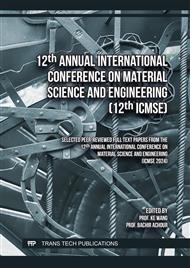[1]
Fu Guangming, Yan Jiayong, Zhang Kun et. Status and Progress of Lithological Identification Technology[J]. Progress in Geophysics | Prog Geophys, 2017, 32(1)p.26
Google Scholar
[2]
Huang Pingping. Rock Blastability Classification with Fuzzy Synthesis[J]. Quarterly Journal of Changsha Institute of Mining and Research, 1989, 9(4)p.63
Google Scholar
[3]
Yu Yalun, Wang Desheng, Qu Shijie. owning of the Blasting Compliance of Rocks in Shuichang Open Pit[J]. Chinese Journal of Rock Mechanics and Engineering, 1990, 9(3)p.195
Google Scholar
[4]
He Gongzhuo, Zou Xueqin. A Zoning Gary Model of Blastability of Ore and Rock IN Dong'anshan Iron Mine and Its Application[J]. China Mining Magazine, 1993, 2(5)p.27
Google Scholar
[5]
K. Wang, Y. Liu, P. Li. Recognition method of drilling conditions based on support vector machine[C]//2022 ICPECA, Shenyang, China, 2022: 233-237.
DOI: 10.1109/icpeca53709.2022.9718844
Google Scholar
[6]
Alghandoor A, Phelan P E, Villalobos R, et al. U.S. manufacturing aggregate energy intensity decomposition: The application of multivariate regression analysis[J]. International Journal of Energy Research, 2010, 32(2)p.91
DOI: 10.1002/er.1334
Google Scholar
[7]
Wu Chong. Research on the Acquisition and Application of Drilling Parameters of Rotary Drilling Rigs in Open Pit Mines[D]. Liaoning Technical University. 2015.
Google Scholar
[8]
Feng Panxue, Yang Zhiqiang. Application of Precise Digital Blasting Process Modeling and Effect Evaluation[J]. Non-ferrous Metals (Mining Component).2014, 66(2)p.4
Google Scholar
[9]
Ji Changpeng, Na Zhongwu, Zhang Zhengcheng, etc. A Lithology Recognition Method Based on Mining Drilling Rigs[C]//Proceedings of the China Intelligent Demolition Forum. 2018.
Google Scholar
[10]
Victor, C.G. Rock Drillability Index[M]. Beijing: China Coal Industry Publishing House. 1980.
Google Scholar
[11]
I.А. Tangayev, Drillability and Explosivity of Rock[M]. Beijing: Metallurgical Industry Press. 1987.
Google Scholar
[12]
Zhou Zhihua. Machine Learning[M], Beijing: Tsinghua University publishing Press. 2016.
Google Scholar
[13]
P. Zhao, L. Lai. Analysis of KNN Density Estimation[J]. IEEE Transactions on Information Theory, 2022, 68(12)p.7971
DOI: 10.1109/tit.2022.3195870
Google Scholar
[14]
Lusiola T. Synthesis and processing of KNN powders and thick films for MEMS devices[D]. Cranfield university, 2012.
Google Scholar



